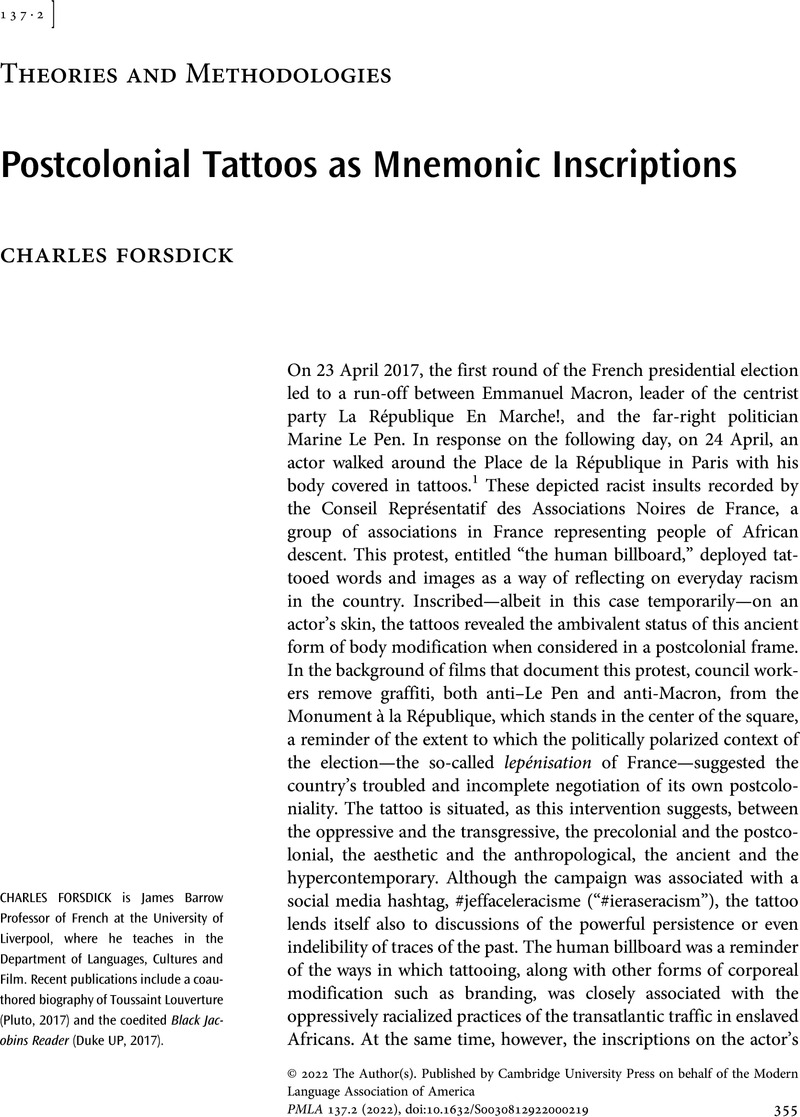No CrossRef data available.
Article contents
Postcolonial Tattoos as Mnemonic Inscriptions
Published online by Cambridge University Press: 25 May 2022
Abstract
An abstract is not available for this content so a preview has been provided. Please use the Get access link above for information on how to access this content.

- Type
- Theories and Methodologies
- Information
- Copyright
- Copyright © 2022 The Author(s). Published by Cambridge University Press on behalf of the Modern Language Association of America
References
Works Cited
Coldrey, Camille. Victor Segalen et l'irruption de la langue tahitienne. L'Harmattan, 2009.Google Scholar
D'Alleva, Anne. “Christian Skins: Tatau and the Evangelization of the Society Islands and Samoa.” Thomas et al., pp. 90–108.Google Scholar
DeMello, Margo. Bodies of Inscription: A Cultural History of the Modern Tattoo Community. Duke UP, 2000.Google Scholar
Dollé, Marie. L’écrit des dits perdus: L'invention des origines dans Les immémoriaux de Victor Segalen. L'Harmattan, 1997.Google Scholar
Feriani, Rim, et al. “Reading Signs and Symbols with Abdelkébir Khatibi: From the Body to the Text.” Hiddleston and Lyamlahy, pp. 237–60.Google Scholar
Forsdick, Charles. “Segalen and Khatibi: Bilingualism, Alterity and the Poetics of Diversity.” Hiddleston and Lyamlahy, pp. 173–95.Google Scholar
Frengs, Julia L. “Literature; or, The Travelling Tattoo: Mobile Manuscripts in the Works of Déwé Gorodé and Stéphanie Ari'irau Richard'Vivi.” Francosphères, vol. 6, no. 2, 2017, pp. 163–78.CrossRefGoogle Scholar
Hiddleston, Jane, and Lyamlahy, Khalid, editors. Abdelkébir Khatibi: Postcolonialism, Transnationalism and Culture in the Maghreb and Beyond. Liverpool UP, 2020.CrossRefGoogle Scholar
J'efface le racisme. Conseil Représentatif des Associations Noires, www.jeffaceleracisme.fr/.Google Scholar
Khatibi, Abdelkébir. “Entretien avec Khatibi.” Interview by Scemla, Jean, Bulletin de l'Association Victor Segalen, no. 2, 1989, pp. 9–10.Google Scholar
Khatibi, Abdelkébir. Figures de l’étranger dans la littérature française. Denoël, 1987.Google Scholar
Khatibi, Abdelkébir. La mémoire tatouée: Autobiographie d'un décolonisé. 1971. Œuvres de Abdelkébir Khatibi I: Romans et récits, La Différence, 2008, pp. 9–113.Google Scholar
Khatibi, Abdelkébir. “Tanizaki revisité.” Œuvres de Abdelkébir Khatibi III: Essais, La Différence, 2008, pp. 225–32.Google Scholar
Khatibi, Abdelkébir. Tattooed Memory. Translated by Thompson, Peter, L'Harmattan, 2016.Google Scholar
Kuwahara, Makiko. “Multiple Skins: Space, Time and Tattooing in Tahiti.” Thomas et al., pp. 171–90.Google Scholar
McNeece, Lucy Stone. “Decolonizing the Sign: Language and Identity in Abdelkébir Khatibi's La mémoire tatouée.” Yale French Studies, no. 83, 1993, pp. 12–29.CrossRefGoogle Scholar
Sawada, Nao. “Maghrebian Shadows: Abdelkébir Khatibi and Japanese Culture.” Hiddleston and Lyamlahy, pp. 219–33.CrossRefGoogle Scholar
Thomas, Nicholas. Introduction. Thomas et al., pp. 7–29.Google Scholar
Thomas, Nicholas, et al. , editors. Tattoo: Bodies, Art and Exchange in the Pacific and the West. Reaktion, 2005.Google Scholar
Treagus, Mandy. “Representing Pacific Tattoos: Issues in Postcolonial Critical Practice.” Journal of Postcolonial Writing, vol. 44, no. 2, 2008, pp. 183–92.CrossRefGoogle Scholar




